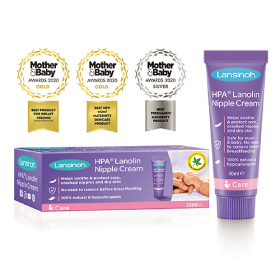Advice Articles
- Home
- Advice Articles
- Baby Skincare
- Mastitis
Mastitis

Symptoms of Mastitis:
- develop a sore, hard lump in your breast
- feel unusual warmth in an area of your breast
- notice redness and soreness in this area
- experience general lumpiness after feeding
- feel achy and run down
Mastitis Treatment:
- feed your baby often on both sides, every 2-3 hours (including night-time), draining the affected breast, and expressing between feeds
- try to get more rest
- apply wet or dry heat to the affected area (e.g. Lansinoh Thera Pearl, hot water bottle, warm compress, a bath or shower)
- massage from the chest wall to the nipple over the sore area before and during feeding
- avoid wearing constricting clothing
However, if after 8-24 hours, there is no improvement and/or you:
- develop a temperature above 38.4ºC
- discover pus or blood in your breastmilk
- notice red streaks on your breast
- have flu-like symptoms
then it is a good idea to visit your doctor, who may suggest a course of antibiotics for mastitis that are compatible with breastfeeding.
Causes of Mastitis include:
- abrupt weaning or irregular feeding patterns, resulting in your breasts becoming full or engorged
- restrictive clothing, or pressure on the breast
- poor attachment of the baby at the breast
- sore or cracked nipples
Effective milk removal is most important, and from birth early, frequent and unrestricted breastfeeding help to achieve this. Your resistance to infection will be lowered if you are anaemic, run down or overly tired.
Feeding your baby during a bout of Mastitis
It is important to continue breastfeeding during mastitis, so as to avoid the possibility of developing a breast abscess. Breastfeeding at this time will not be harmful to your baby, as your milk contains antibodies that protect him from infection
Mastitis usually only affects one breast. Feeding from the affected breast first is recommended. Your breastmilk may taste saltier, and it can help to try different feeding positions to encourage your baby to accept the breast. If a baby is still reluctant many mothers express milk, which maintains the milk supply until the salty taste is lost, usually within a week.
You may also find it helpful to read our handy guide to sore nipples when breastfeeding, including hints and tips to help sore nipples
Related Categories
Related Products
-

HPA® Lanolin Nipple Cream for Sore & Cracked Nipples
Sore nipples are very common during breastfeeding and can often be a result of the uncomfortable positioning... View
